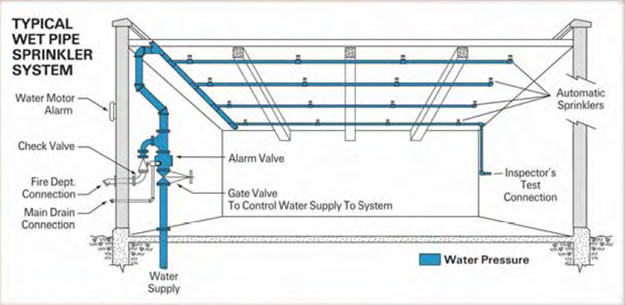 Source; http://www.sixmotechnologies.com/services-automatic-fire-sprinkler-system.php
Source; http://www.sixmotechnologies.com/services-automatic-fire-sprinkler-system.php
Fire safety is an imperative aspect of any structure. The environmental burden of fire safety systems need to be initially assessed. This would essentially include the raw material procurement, manufacturing, transportation, operation until the end life of the product. Sprinkler piping is subject to corrosion as the pipes are filled with stagnant water for regular intervals. Microbiologically induced corrosion is the major cause of pipe failure. Flushing of the pipes at regular intervals can reduce the rate of failure.
According to the national estimates of reported fires from the U.S Fire Administration’s National Fire Incident Reporting (NFIRS) and NFPA’s annual survey showed that 92% of the large fires which could be detected by sprinkler systems were effectively contained and also the civilian injuries were accounted as 67% lesser when compared to fire statistics studies carries out in buildings with no automatic extinguishing systems. (Ahrens, 2017). The statistics emphasize on the critical nature of the sprinkler systems in facilities. Repairs and maintenance strategies are to be implemented based on the analysis of the effect of the failure of the system on lives and property. Since these system are in the dormant state during most of the lifetime of the system, it is unlikely to determine the possible failures of the system during the operation cycle, Thus, inspection of the system components as per the guidelines of NFPA 25 is necessary to maintain the reliability of the system.
Hence, Wet sprinkler systems are a safety critical component in building design and have considerable impact on the environment in terms of the manufacturing stage, operation and even the disposal. An LCA is necessary to make decisions of material selection of systems at the early design stage itself to reduce the impact of these systems on the environment. The goal of this project is to find the most feasible option in terms of less environmental impact. Along with this, the interventions of maintenance strategies of the system are also analyzed. The functional unit of this study is flexible based on the multi storey building dimensions. While the Life cycle Inventory is based on input and output values of 1m length of the respective pipe under analysis.
Furthermore, this study create a foundation for future extensions of the LCA with new materials, different dimensions, and suspension systems. Three different materials are assessed for sprinkler piping from cradle to gate and the analysis of the best design option is further assessed through multi criteria decision analysis and a conclusion is arrived upon selecting PVC pipes for less environmental impact cost.
For more insight of the project different civil engineering systems within the Integration context are followed; Shopping center (focus on elevator), a Eternal thermal insulation composite system and a Climate envelope (focus on girders). All of these products are incorporated in overall Integrated maintenance planning and are beeing assessed to define the impact of the integration on Integrated life-cycle analysis by a Integrated maintenance plan by multi-objective optimization.
References
-
Ahrens, M. (2017) ‘U . S . Experience with Sprinklers’, (July).
-
Ahrens, M. and Wilmot, J. (no date) ‘Sprinkler Performance –How are we doing ? How can NFPA 13 and 25 help ?
-
Butry, D. T. (2009) ‘Economic performance of residential fire sprinkler systems’, Fire Technology, 45(1), pp. 117–143. doi: 10.1007/s10694-008-0054-8
-
Chu, S. K. (2004) ‘Preventive Maintenance for Fire Engineering System in Residential Buildings (Case Study)’, International Journal on Engineering Performance-Based Fire Codes, 6(4), pp. 307–321.
-
Frank, K. et al.(2013) ‘A review of sprinkler system effectiveness studies’, Fire Science Reviews, 2(1), p. 6. doi: 10.1186/2193-0414-2-6.
Navigation